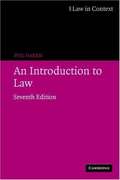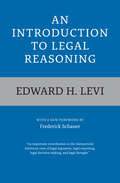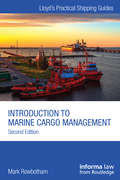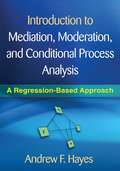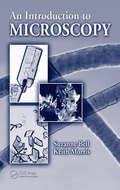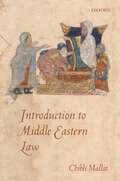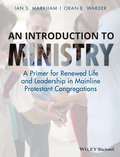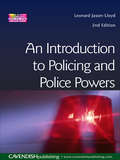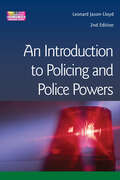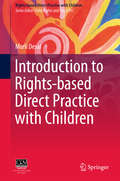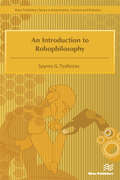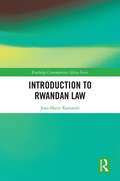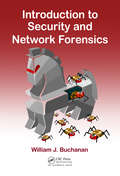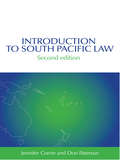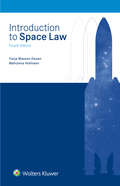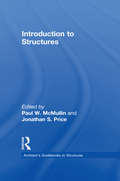- Table View
- List View
An Introduction to Law (Seventh Edition) (PDF)
by Phil HarrisSince the publication of its first edition, this textbook has become the definitive student introduction to the subject. As with earlier editions, the seventh edition gives a clear understanding of fundamental legal concepts and their importance within society. In addition, this book addresses the ways in which rules and the structures of law respond to and impact upon changes in economic and political life. The title has been extensively updated and explores recent high profile developments such as the Civil Partnership Act 2005 and the Racial and Religious Hatred Bill. This introductory text covers a wide range of topics in a clear, sensible fashion giving full context to each. For this reason, An Introduction to Law is ideal for all students of law, be they undergraduate law students, those studying law as part of a mixed degree, or students on social sciences courses which offer law options.
An Introduction to Legal Reasoning
by Edward H. LeviOriginally published in 1949, An Introduction to Legal Reasoning is widely acknowledged as a classic text. As its opening sentence states, “This is an attempt to describe generally the process of legal reasoning in the field of case law and in the interpretation of statutes and of the Constitution.” In elegant and lucid prose, Edward H. Levi does just that in a concise manner, providing an intellectual foundation for generations of students as well as general readers. For this edition, the book includes a substantial new foreword by leading contemporary legal scholar Frederick Schauer that helpfully places this foundational book into its historical and legal contexts, explaining its continuing value and relevance to understanding the role of analogical reasoning in the law. This volume will continue to be of great value to students of logic, ethics, and political philosophy, as well as to members of the legal profession and everyone concerned with problems of government and jurisprudence.
An Introduction to Legal Reasoning
by Edward H. LeviOriginally published in 1949, An Introduction to Legal Reasoning is widely acknowledged as a classic text. As its opening sentence states, “This is an attempt to describe generally the process of legal reasoning in the field of case law and in the interpretation of statutes and of the Constitution.” In elegant and lucid prose, Edward H. Levi does just that in a concise manner, providing an intellectual foundation for generations of students as well as general readers. For this edition, the book includes a substantial new foreword by leading contemporary legal scholar Frederick Schauer that helpfully places this foundational book into its historical and legal contexts, explaining its continuing value and relevance to understanding the role of analogical reasoning in the law. This volume will continue to be of great value to students of logic, ethics, and political philosophy, as well as to members of the legal profession and everyone concerned with problems of government and jurisprudence.
An Introduction to Legal Reasoning
by Edward H. LeviOriginally published in 1949, An Introduction to Legal Reasoning is widely acknowledged as a classic text. As its opening sentence states, “This is an attempt to describe generally the process of legal reasoning in the field of case law and in the interpretation of statutes and of the Constitution.” In elegant and lucid prose, Edward H. Levi does just that in a concise manner, providing an intellectual foundation for generations of students as well as general readers. For this edition, the book includes a substantial new foreword by leading contemporary legal scholar Frederick Schauer that helpfully places this foundational book into its historical and legal contexts, explaining its continuing value and relevance to understanding the role of analogical reasoning in the law. This volume will continue to be of great value to students of logic, ethics, and political philosophy, as well as to members of the legal profession and everyone concerned with problems of government and jurisprudence.
An Introduction to Legal Reasoning
by Edward H. LeviOriginally published in 1949, An Introduction to Legal Reasoning is widely acknowledged as a classic text. As its opening sentence states, “This is an attempt to describe generally the process of legal reasoning in the field of case law and in the interpretation of statutes and of the Constitution.” In elegant and lucid prose, Edward H. Levi does just that in a concise manner, providing an intellectual foundation for generations of students as well as general readers. For this edition, the book includes a substantial new foreword by leading contemporary legal scholar Frederick Schauer that helpfully places this foundational book into its historical and legal contexts, explaining its continuing value and relevance to understanding the role of analogical reasoning in the law. This volume will continue to be of great value to students of logic, ethics, and political philosophy, as well as to members of the legal profession and everyone concerned with problems of government and jurisprudence.
Introduction to Marine Cargo Management (Lloyd's Practical Shipping Guides)
by Mark RowbothamCargo management, especially in the maritime sphere, plays a vital role in the transfer of goods between seller and buyer. However, despite over 90% of the world’s international trade being conducted by sea, often very little is known about this subject by either party. This unique text provides a clear and comprehensive introduction to the principal elements involved in the management of marine cargo and the carriage of goods by sea. Not only does it analyse key theories and debates in the maritime freight sector, it is equally instructive on practice and logistics. Furthermore, the book provides a thorough guide to the roles and responsibilities of all parties involved in this dynamic industry. This second edition has been fully revised and updated to incorporate the very latest changes in cargo management legislation and procedures, including: Offshore oil & gas supply management The revised INCOTERMS 2010 Tramp shipping and spot cargo trading Project cargo management Dry and liquid bulk cargo management The IMDG Code and the marine carriage of dangerous and hazardous goods Cabotage Salvage Risk management and best practice This is an essential guide for shipping professionals, academics and students of marine logistics, and international trade.
Introduction to Marine Cargo Management (Lloyd's Practical Shipping Guides)
by Mark RowbothamCargo management, especially in the maritime sphere, plays a vital role in the transfer of goods between seller and buyer. However, despite over 90% of the world’s international trade being conducted by sea, often very little is known about this subject by either party. This unique text provides a clear and comprehensive introduction to the principal elements involved in the management of marine cargo and the carriage of goods by sea. Not only does it analyse key theories and debates in the maritime freight sector, it is equally instructive on practice and logistics. Furthermore, the book provides a thorough guide to the roles and responsibilities of all parties involved in this dynamic industry. This second edition has been fully revised and updated to incorporate the very latest changes in cargo management legislation and procedures, including: Offshore oil & gas supply management The revised INCOTERMS 2010 Tramp shipping and spot cargo trading Project cargo management Dry and liquid bulk cargo management The IMDG Code and the marine carriage of dangerous and hazardous goods Cabotage Salvage Risk management and best practice This is an essential guide for shipping professionals, academics and students of marine logistics, and international trade.
Introduction To Mediation, Moderation, And Conditional Process Analysis: A Regression-based Approach (PDF)
by Andrew F. HayesExplaining the fundamentals of mediation and moderation analysis, this engaging book also shows how to integrate the two using an innovative strategy known as conditional process analysis. Procedures are described for testing hypotheses about the mechanisms by which causal effects operate, the conditions under which they occur, and the moderation of mechanisms. Relying on the principles of ordinary least squares regression, Andrew Hayes carefully explains the estimation and interpretation of direct and indirect effects, probing and visualization of interactions, and testing of questions about moderated mediation. Examples using data from published studies illustrate how to conduct and report the analyses described in the book. Of special value, the book introduces and documents PROCESS, a macro for SPSS and SAS that does all the computations described in the book. The companion website (www. afhayes. com) offers free downloads of PROCESS plus data files for the book's examples. Unique features include: *Compelling examples (presumed media influence, sex discrimination in the workplace, and more) with real data; boxes with SAS, SPSS, and PROCESS code; and loads of tips, including how to report mediation, moderation and conditional process analyses. *Appendix that presents documentation on use and features of PROCESS. *Online supplement providing data, code, and syntax for the book's examples.
An Introduction to Microscopy
by Suzanne BellMicroscopy, which has served as a fundamental scientific technique for centuries, remains an invaluable tool in chemistry, biology, healthcare, and forensics. Increasingly, it is being integrated into modern chemical instrumentation and is of value as a powerful analytical tool across many scientific disciplines. Designed to serve as a primary reso
Introduction to Middle Eastern Law
by Chibli MallatThis book provides an introduction to the laws of the Middle East, defining the contours of a field of study that deserves to be called 'Middle Eastern law'. It introduces Middle Eastern law as a reflection of legal styles, many of which are shared by Islamic law and the laws of Christian and Jewish Near Eastern communities. It offers a detailed survey of the foundations of Middle Eastern law, using court archives and an array of legal sources from the earliest records of Hammurabi to the massive compendia of law in the Islamic classical age through to the latest decisions of Middle Eastern high courts. It focuses on the way legislators and courts conceive of law and apply it in the Middle East. It builds on the author's extensive legal practice, with the aim of introducing the Middle Eastern law's main sources and concepts in a manner accessible to non-specialist legal scholars and practitioners alike. The book begins with an exploration of the depth and variety of Middle Eastern law, introducing the concepts of shari'a, fiqh, and qanun, (which all mean 'law'), and dwelling on Islamic law as the 'common law' of the Middle East. It provides a historical introduction to the contemporary Middle East, exploring political systems, constitutional law, judicial review, the laws of tort and obligations, commercial law (including Islamic banking, company law, capital markets, and commercial arbitration); and examines legislative reform in family law and the position of women in the legal system. The author considers the interaction between Islamic and Western laws and includes a bibliography designed for further research into the jurisdictions and themes explored throughout the book.
An Introduction to Ministry: A Primer for Renewed Life and Leadership in Mainline Protestant Congregations
by Ian S. Markham Oran E. WarderAn Introduction to Ministry is a comprehensive and ecumenical introduction to the craft of ministry for ministers, pastors, and priests that make up the mainline denominations in the United States. Ecumenically-focused, It offers a grounded account of ministry, covering areas such as vocation, congregational leadership, and cultivation of skills for an effective ministry. Covers the key components of the M.Div. curriculum, offering a map and guide to the central skills and issues in training Explores the areas of vocation, skills for ministry, and issues around congregational leadership Each topic ends with an annotated bibliography providing an indispensable gateway to further study Helps students understand both the distinctive approach of their denomination and the relationship of that approach to other mainline denominations Advocates and defends a generous understanding of the Christian tradition in its openness and commitment to broad conversation
An Introduction to Ministry: A Primer for Renewed Life and Leadership in Mainline Protestant Congregations
by Ian S. Markham Oran E. WarderAn Introduction to Ministry is a comprehensive and ecumenical introduction to the craft of ministry for ministers, pastors, and priests that make up the mainline denominations in the United States. Ecumenically-focused, It offers a grounded account of ministry, covering areas such as vocation, congregational leadership, and cultivation of skills for an effective ministry. Covers the key components of the M.Div. curriculum, offering a map and guide to the central skills and issues in training Explores the areas of vocation, skills for ministry, and issues around congregational leadership Each topic ends with an annotated bibliography providing an indispensable gateway to further study Helps students understand both the distinctive approach of their denomination and the relationship of that approach to other mainline denominations Advocates and defends a generous understanding of the Christian tradition in its openness and commitment to broad conversation
Introduction to Policing and Police Powers
by Leonard Jason-LloydFirst published in 2005. Routledge is an imprint of Taylor & Francis, an informa company.
Introduction to Policing and Police Powers
by Leonard Jason-LloydFirst published in 2005. Routledge is an imprint of Taylor & Francis, an informa company.
Introduction to Rights-based Direct Practice with Children (Rights-based Direct Practice with Children)
by Murli DesaiThe Sourcebook introduces the theoretical and ideological foundation and methodological basis of Rights-based Direct Practice with Children. It starts with the methodology of participatory group workshops to facilitate learning of the content. The content draws linkages among the foundation of life skills; psychosocial, sociological and critical theories of childhood; and child rights values, categories and principles; with the approaches, methods and skills of direct practice with children. The book takes examples from India but makes significant contribution to training and reference material for child rights teachers, trainers, facilitators and field workers, across the world, especially in the developing countries.
An Introduction to Robophilosophy Cognition, Intelligence, Autonomy, Consciousness, Conscience, and Ethics
by Spyros G. TzafestasModern robots have arrived at a very matured state both in their mechanical / control aspects and their mental aspects. An Introduction to Robophilosophy explores the philosophical questions that arise in the development, creation, and use of mental – anthropomorphic and zoomorphic- robots that are capable of semiautonomous / autonomous operation, decision making and human-like action, being able to socially interact with humans and exhibit behavior similar to human beings or animals. Coverage first presents fundamental concepts, and an overview of philosophy, philosophy of science, and philosophy of technology. The six principal mental capabilities of modern robots, namely cognition, intelligence, autonomy, consciousness, conscience, and ethics are then studied from a philosophical point of view. They actually represent the product of technological embodiment of cognitive features to robots. Overall, readers are provided a consolidated thorough investigation of the philosophical aspects of these mental capabilities when embedded to robots. This book will serve as an ideal educational source in engineering and robotics courses as well as an introductory reference for researchers in the field of robotics, and it includes a rich bibliography.
An Introduction to Robophilosophy Cognition, Intelligence, Autonomy, Consciousness, Conscience, and Ethics
by Spyros G. TzafestasModern robots have arrived at a very matured state both in their mechanical / control aspects and their mental aspects. An Introduction to Robophilosophy explores the philosophical questions that arise in the development, creation, and use of mental – anthropomorphic and zoomorphic- robots that are capable of semiautonomous / autonomous operation, decision making and human-like action, being able to socially interact with humans and exhibit behavior similar to human beings or animals. Coverage first presents fundamental concepts, and an overview of philosophy, philosophy of science, and philosophy of technology. The six principal mental capabilities of modern robots, namely cognition, intelligence, autonomy, consciousness, conscience, and ethics are then studied from a philosophical point of view. They actually represent the product of technological embodiment of cognitive features to robots. Overall, readers are provided a consolidated thorough investigation of the philosophical aspects of these mental capabilities when embedded to robots. This book will serve as an ideal educational source in engineering and robotics courses as well as an introductory reference for researchers in the field of robotics, and it includes a rich bibliography.
Introduction to Rwandan Law (Routledge Contemporary Africa)
by Jean-Marie KamataliThis book explores key innovations in Rwandan law, exploring how the homegrown legal system with the civil law and common law legal systems. The author explores the history of Rwandan law through pre-colonial, to colonial and post-independence periods, examines the homegrown legal and justice approaches, such as Gacaca, Abunzi and Imihigo, introduced in post genocide Rwanda to deal with legal problems that could not be dealt with using the western legal system; and highlights the innovative Rwandan approach to incorporating international law in the domestic legal system. The book also covers the evolution of the Rwandan Constitutional Law and Constitutionalism since independence; the development of family law from a legal system that oppressed women to one that promotes girls and women rights. Finally, the book explores the contribution of common law in the transformation of the organization, jurisdiction and functioning of Rwandan Courts. This book will be of interest to scholars and students of African law, international law and the legal system in Rwanda.
Introduction to Rwandan Law (Routledge Contemporary Africa)
by Jean-Marie KamataliThis book explores key innovations in Rwandan law, exploring how the homegrown legal system with the civil law and common law legal systems. The author explores the history of Rwandan law through pre-colonial, to colonial and post-independence periods, examines the homegrown legal and justice approaches, such as Gacaca, Abunzi and Imihigo, introduced in post genocide Rwanda to deal with legal problems that could not be dealt with using the western legal system; and highlights the innovative Rwandan approach to incorporating international law in the domestic legal system. The book also covers the evolution of the Rwandan Constitutional Law and Constitutionalism since independence; the development of family law from a legal system that oppressed women to one that promotes girls and women rights. Finally, the book explores the contribution of common law in the transformation of the organization, jurisdiction and functioning of Rwandan Courts. This book will be of interest to scholars and students of African law, international law and the legal system in Rwanda.
Introduction to Security and Network Forensics
by William J. BuchananKeeping up with the latest developments in cyber security requires ongoing commitment, but without a firm foundation in the principles of computer security and digital forensics, those tasked with safeguarding private information can get lost in a turbulent and shifting sea. Providing such a foundation, Introduction to Security and N
Introduction to South Pacific Law
by Jennifer Corrin Don PatersonProviding an overview of the origins and development of the law and legal systems in the South Pacific, the authors examine the framework of legal systems in the region and the operation of state and customary laws. Exploring, not only the legal system generally, but also the constitution and jurisdiction of state courts and legislative provisions of individual jurisdictions and cases, it contains individual chapters on substantive areas of law. They cover: administrative law constitutional law contract law criminal law customary law family law land law tort law. Highlighting the distinguishing features of the substantive law in force in the South Pacific, this book is an essential resource for all those interested in the law of the South Pacific Islands region.
Introduction to South Pacific Law
by Jennifer Corrin Don PatersonProviding an overview of the origins and development of the law and legal systems in the South Pacific, the authors examine the framework of legal systems in the region and the operation of state and customary laws. Exploring, not only the legal system generally, but also the constitution and jurisdiction of state courts and legislative provisions of individual jurisdictions and cases, it contains individual chapters on substantive areas of law. They cover: administrative law constitutional law contract law criminal law customary law family law land law tort law. Highlighting the distinguishing features of the substantive law in force in the South Pacific, this book is an essential resource for all those interested in the law of the South Pacific Islands region.
Introduction to Space Law
by Tanja Masson-Zwaan Mahulena HofmannThe relevance and substance of space law as a branch of public international law continues to expand. The fourth edition of this long-time classic in the field of space law has been substantially rewritten to reflect new developments in space law and technology of the past ten years. This updated text includes new or expanded material on the proliferation of non-state and commercial entities as space actors, the appearance of innovations in space technology, the evolving international law of satellite telecommunications in a networked world, and the adoption of national laws and international soft law mechanisms that complement the international treaty regime. In this up-to-date overview of space law, the authors offer a clear analysis of the legal challenges that play a role in new and traditional areas of space activity, including the following: - the peaceful uses of outer space; - protection of the space environment; - the emergence of new legal mechanisms in space law; - the role of Europe in space; - telecommunications; - the commercial use of space resources; - human space flight; - small satellites; - remote sensing; and - global navigation satellite systems. Additionally, the five United Nations Treaties on space are included as Annexes for easy reference by students and professionals alike. In light of the many new developments in the field, this thoroughly updated Introduction to Space Law provides a clear overview of the legal aspects of a wide array of current and emerging space activities. Lawyers, policy-makers, diplomats, students, and professionals in the telecommunication and aerospace sectors, with or without a legal background, will find concise yet comprehensive guidance in this book that will help them understand and address legal issues in the ever-changing field of space activities. The authors are close former collaborators of the late pioneers of space law and authors of the earlier editions of this volume, Isabella Diederiks-Verschoor and Vladimír Kopal.
Introduction to Structures (Architect's Guidebooks to Structures)
by Paul W. McMullin Jonathan S. PriceIntroduction to Structures - the lead book in the Architect’s Guidebook to Structures series - presents structures in simple, accessible fashion through beautiful illustrations, worked examples, and from the perspective of practicing professionals with a combined experience of over 75 years. It introduces the student to, and reminds the practitioner of, fundamental structural design principles. Beginning by introducing structural forms in nature and history, the process of design, and selecting structural systems and materials, the book then moves onto statics, mechanics of materials, and structural analysis. The final chapter provides guidance on preliminary structural design, complete with decision criteria and design tables. Edited by experienced professional structural engineers, with vital contributions from practicing architects, Introduction to Structures is fully illustrated, contains clear step by step examples and preliminary design guidance. Designed as a key textbook for introductory structures courses, it is also an indispensable reference for practicing architects.
Introduction to Structures (Architect's Guidebooks to Structures #1)
by Paul W. McMullin Jonathan S. PriceIntroduction to Structures - the lead book in the Architect’s Guidebook to Structures series - presents structures in simple, accessible fashion through beautiful illustrations, worked examples, and from the perspective of practicing professionals with a combined experience of over 75 years. It introduces the student to, and reminds the practitioner of, fundamental structural design principles. Beginning by introducing structural forms in nature and history, the process of design, and selecting structural systems and materials, the book then moves onto statics, mechanics of materials, and structural analysis. The final chapter provides guidance on preliminary structural design, complete with decision criteria and design tables. Edited by experienced professional structural engineers, with vital contributions from practicing architects, Introduction to Structures is fully illustrated, contains clear step by step examples and preliminary design guidance. Designed as a key textbook for introductory structures courses, it is also an indispensable reference for practicing architects.
